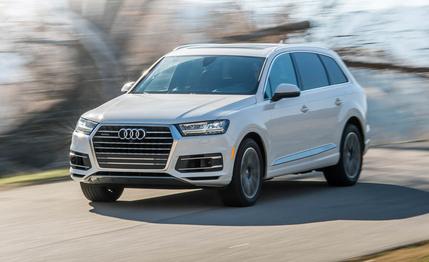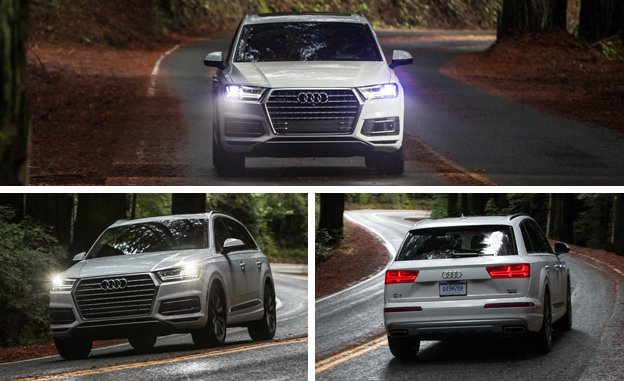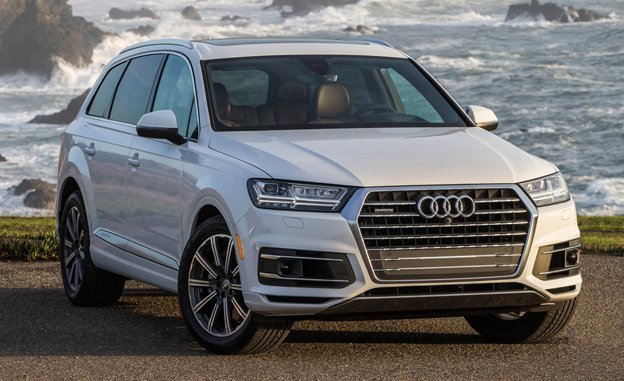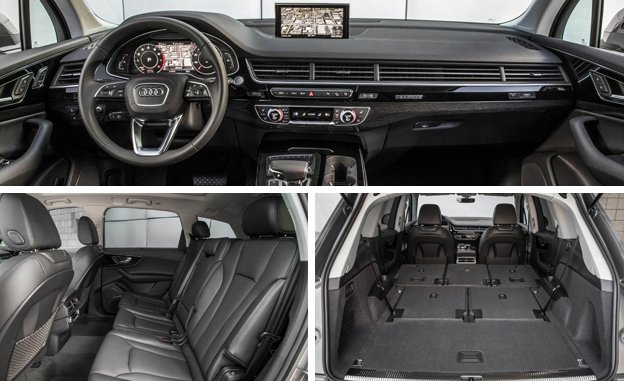
 Instrumented Test
Instrumented Test
Opting for a crossover utility vehicle with a third row of seats usually means dialing back the driving enjoyment. That isn’t the case with the new 2017 Audi Q7, however, thanks to significant weight savings over its predecessor and a heaping portion of advanced technology. We’ve already explored the second-gen Q7’s plethora of features and had our first experience behind the steering wheel. But now we’ve finally strapped our test gear to one and can confirm that Audi’s formula works. Big time.
The Q7 rides on the Volkswagen Group’s latest MLB II architecture and is said to be significantly lighter than before. Contributions to the diet include a high-strength steel structure largely skinned with aluminum panels, copious amounts of aluminum in the revised front and rear multilink suspension, and a standard eight-speed automatic gearbox that integrates the Quattro all-wheel-drive system’s transfer case. Audi claims weight savings in excess of 700 pounds, but our scales told a more modest story—our 3.0T Prestige test car was only 270 pounds lighter than the previous 2011 model we tested. Still, the resulting improvements are significant.


Powering our Q7 was Audi’s familiar supercharged 3.0-liter gasoline V-6 developing 333 horsepower and a meaty 325 lb-ft of torque, the latter from just 2900 rpm. The gas V-6 is a fantastic engine, with excellent response and an aggressive snarl. Despite the still-hefty 5080 pounds it had to move, the 3.0T dashed to 60 mph in 5.5 seconds and covered the quarter-mile in 14.2 at 99 mph—1.1 and 0.8 seconds quicker than before, and speedier than the BMW X5 xDrive35i and the new 2016 Volvo XC90. Aided by chunky 285/45 Goodyear Eagle Sport all-season tires on 20-inch wheels, the Q7 circled the skidpad with an impressive 0.85 g of lateral grip and chopped eight feet from the previous model’s stopping performance, now registering a 70-to-0-mph stop of 166 feet.
Although the second-gen Q7 is about the same overall height as the original, it’s slightly tidier in other dimensions, and its proportions look positively wagonlike on the street. The carlike impression carries over to its driving behavior, with little pitch or roll from the body and a nimbleness that belies its considerable mass. Along with Quattro all-wheel drive and a brake-based torque-vectoring system, our test car also had the $4000 Adaptive Chassis package, which adds true four-wheel steering and adaptive air suspension with five different ride heights. Audi’s Drive Select also is included and adjusts the suspension, engine, transmission, and more via Comfort, Auto, Dynamic, Allroad, Off-Road, and Individual mode settings.
Whereas many large crossovers teeter and understeer through transitions, the Q7 dives into corners and stays low, flat, and composed. Even when hustled through the tight mountain roads of our Southern California test route, the big Audi could be aggressively flung into switchbacks without getting flustered, the four-wheel steering and chassis technology sorting out the various forces acting upon the car. Outward visibility is good, thanks to the relatively low cowl and thin pillars. And the electric power steering is precise and well balanced, albeit short on feedback. But this is still a 2.5-ton family hauler we’re talking about.
The Q7 will even do some of the dynamic work for you via its trick adaptive cruise control, which pairs with the navigation system and Google Maps to brake and accelerate through upcoming corners and even add slight steering inputs. This being an Audi, there’s a bold, new trapezoidal grille flanked by the latest adaptive LED headlights, which absolutely flood the road ahead with searing white light. Equally important, switching from Dynamic to Auto or Comfort mode relaxes everything and makes for plush long-distance cruising.


The EPA has yet to officially rate the new Q7, but we’re expecting ratings close to 18 mpg in the city and 27 on the highway. Given our exuberance during back-road blasts in the Audi, our observed 17 mpg was less than stellar. Your mileage will be better, and we’ll revisit the Q7’s fuel economy in subsequent tests.
We’d also like to revisit our opinion of the Q7’s styling, which wasn’t done any favors by our test example’s Glacier White paint ($575). It didn’t look bad, but the light hue hid many of the design’s various facets and cut-lines, making it appear rather blobbish. We all agree, however, that the latest Audi’s interior is a modern, wonderful place to sit, even if the power-folding third row is barely larger than before and quite tight for adults.
Highlighted by the Audi Virtual Cockpit’s huge 12.3-inch TFT configurable display in the cluster, as well as the latest MMI interface and a second 8.3-inch screen that pops out of the dash, the Q7’s cabin is a techno-wonder. The general ergonomics are very clever once you’re familiar with them, and having the gigantic navigation display in the cluster is great for tackling challenging roads and negotiating unfamiliar areas. Audi’s fit and finish and attention to detail remain excellent. And our test car’s sumptuous wood trim and rich, Nougat Brown leather contrasted nicely with the hi-res displays and fancy switchgear, giving a private-jet sort of vibe.
The 2017 Q7 comes nicely equipped to start at $55,750 and is about six grand more than the previous 2015 version (there was no 2016 model). The top-level Prestige trim ($9500) adds most of the cool features, including the Virtual Cockpit, the larger central display, a handwriting recognition touchpad for the MMI system, the LED headlights, heated and ventilated front seats, a premium Bose audio system, head-up display, four-zone climate control, and much more.


Along with the chassis and suspension upgrades, our test car also included the $2400 Driver Assistance package (adaptive cruise with full stop-and-go capability, lane-departure assist, auto high-beams, and traffic-sign recognition) and a couple of other options for a sizable total of $72,875. But prices can climb much higher with additional extras, such as massaging front seats, night vision, a Bang & Olufsen stereo with 23 speakers, and rear-seat entertainment.
The fully redesigned Volvo XC90 is the other fresh player in the Q7’s segment, and it’s very nice and quite roomy, but it’s not as sharp to drive as the Audi. We’ll have a comparison test dialed up soon, but Audi’s infusion of lightness and technology has created one impressive people hauler.